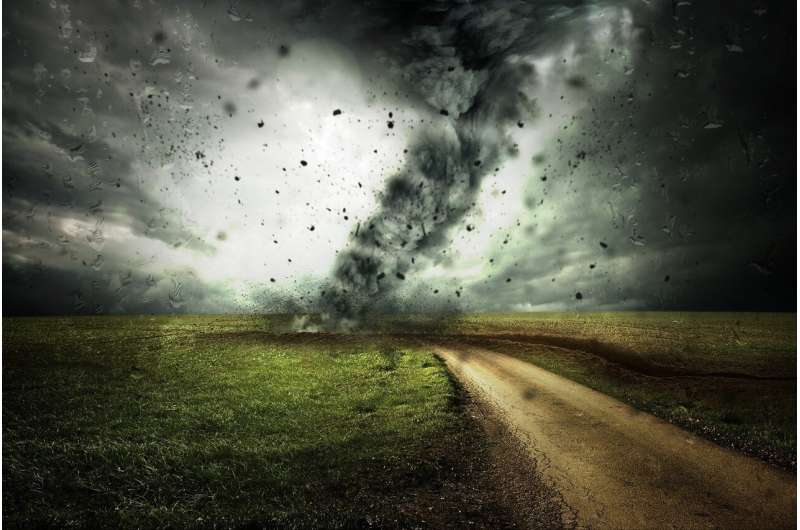Credit: Pixabay/CC0 Public Domain
Faced with several recent studies showing climate change will make San Diego highly vulnerable to sea level rise and severe wildfires, city officials are launching a campaign to make the city more resilient and better prepared.
The campaign, called Climate Resilient SD, will create a variety of adaptation strategies, determine which strategies to prioritize in which parts of the city and contemplate how to pay for them with grants and other resources.
City officials say the adaptation strategies will address each of the five largest threats that climate change poses for San Diego: severe wildfires, droughts, flooding, sea level rise and extreme heat waves.
There also will be an equity element focused on things like helping neighborhoods where air conditioning is scarce during heat waves, which are expected to become more common as the climate changes.
While safety and preserving quality of life will be the highest priorities, the campaign also will consider the effects of climate change on the economy. If sea level rise wipes out beaches, for instance, San Diego's tourism economy could suffer.
The plan that results from the campaign, which is expected to be presented to the City Council for approval by the end of the year, will also include input from residents gathered from two online surveys.
"What sort of city do we need to plan for as we address a changing climate?" Mike Hansen, the city's planning director, asked this week. "It's really about looking at these trends to make sure we can respond and recover as a city."
While there is no analysis showing San Diego faces greater threats from climate change than other cities, it certainly faces a great variety of challenges, Hansen said.
"Our vulnerabilities are pretty multi-faceted because our city spans a pretty big geography and a pretty varied geography," he said. "We don't just have coastal areas—we have canyons, we have rivers with potential flooding risks and we have different climates that pose different risks of extreme heat."
That's in addition to the city's "wildland urban interface," an area vulnerable to wildfires along the eastern edges of communities like Scripps Ranch, Rancho Bernardo and the San Pasqual Valley.
San Diego's vulnerability
A city website devoted to the new campaign summarizes recent studies of San Diego's vulnerability to climate change.
Regarding heat, the city's mild climate usually produces four days per year of what climate experts call extreme heat. That number is expected to rise significantly, and temperatures on days of extreme heat are expected to be even higher than they are now.
By the 2040s, the average daily high could be 5 degrees Fahrenheit higher than it is now, city officials said.
On sea level rise, studies show San Diego could experience an increase of 3.6 feet to 10.2 feet. That's compared to a total increase during the entire 1900s of 0.71 feet.
Sea level rise will mean more flooding and faster rates of erosion along the coastline. That could reduce beach access and damage the tourism economy.
Regarding floods and drought, there is expected to be more variability in rainfall from year to year and more intense transitions between droughts and flood events.
Extreme rainstorms could mean significant flooding, while worse droughts could increase wildfire risk.
Other climate change impacts increasing wildfire risk include higher temperatures, drier conditions and more flammable vegetation.
In addition to loss of life and property, wildfires increase erosion, reduce air and water quality and can decrease biological diversity by destroying habitats.
A landmark plan
San Diego already has begun addressing climate change by boosting its flood prevention efforts, increasing the city's tree canopy to fight extreme heat, and preparing for droughts with the new Pure Water sewage recycling system.
The city also adopted a landmark climate action plan in 2015. The new adaptation strategies approved as part of Climate Resilient SD will be added to the climate action plan, city officials said.
While many of the strategies will be infrastructure projects, they might also be education and outreach initiatives, new programs or policies, and changes to city operations.
The goal of the campaign is making the city more proactive than reactive regarding climate change, said Heidi Vonblum, deputy director of the city's Planning Department.
An example could be boosting the tree canopy in neighborhoods that city officials know will face more extreme heat in the future, and where lower incomes mean air conditioning is less common.
"There are populations that, without a doubt, have less resources to adapt to climate change," Vonblum said.
The public surveys will help city officials craft their strategies and vary them by community.
"There are no one-size-fits-all solutions," Vonblum said. "What works for one community might not work so well for another community."
The first survey, which is underway, asks people about the city's overarching goals and policies. The second will ask for feedback on a rough draft of strategies the city will unveil later this year.
Mayor Todd Gloria said climate change has to be a priority, despite other ongoing concerns.
"While San Diegans remain appropriately focused on the pandemic and its effects, I want everyone to know that the city is actively addressing long-term challenges as well," he said by email. "In response to the biggest one of all—climate change—we're working creatively to reduce greenhouse gas emissions and planning for impacts that we're already experiencing, such as rising sea levels and more frequent and more intense wildfires."
©2021 The San Diego Union-Tribune
Distributed by Tribune Content Agency, LLC.






















